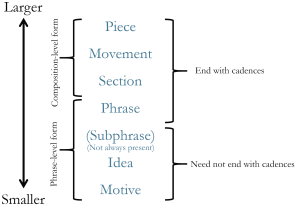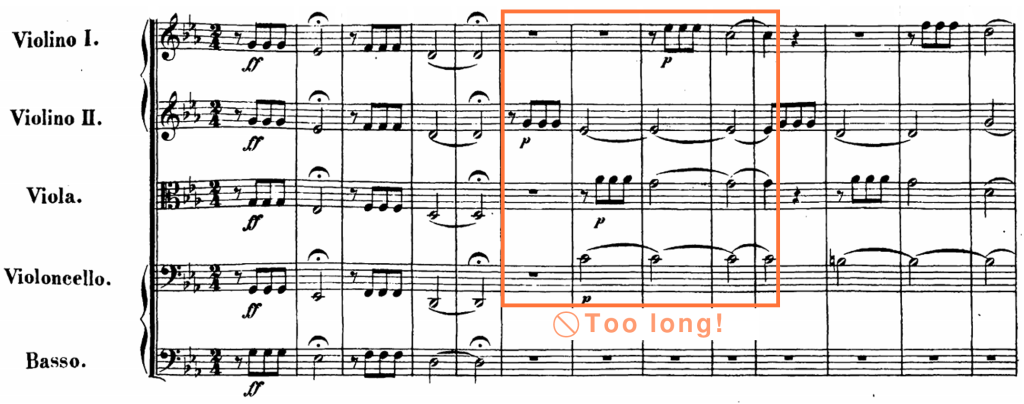III. Form
Foundational Concepts for Phrase-Level Forms
John Peterson
Key Takeaways
This chapter describes the hierarchy of musical form, motives, and segmentation analysis.
- Musical form can be understood as a hierarchical grouping of units.
- The smallest of these groupings is a motive, which is a regularly recurring unit of music that’s typically smaller than an idea. In an analysis, we circle and label motives that recur and are transformed across a work. Avoid identifying large melodies or portions of melodies as motives—motives are short!
- A segmentation analysis is a way to show the grouping units of a passage or whole piece. To do a segmentation analysis, we begin by identifying phrase endings, which are often marked by cadences. Then, we divide phrases into smaller units using square brackets above the score to show the idea level.
Hierarchy

One way to understand musical form is as a hierarchical grouping of units. Example 1 shows that a piece contains movements, movements contain sections, sections contain themes, themes contain phrases, and so on.
Although the diagram in Example 1 looks quite simple, the relationships between the levels are a little more complicated in reality. For instance, sometimes two levels are collapsed into one: a single phrase may comprise an entire section of a work, so it may not always be worthwhile to distinguish between each level. It’s best to think of Example 1 as a guide and not as something that strictly defines formal levels.
This chapter, along with the three that follow it, are focused on phrase-level form, or the various ways in which a phrase may be constructed of motives, ideas, and sometimes subphrases (which will be discussed in later chapters).
Motives
A motive is like a little snippet of a melody. It’s a regularly recurring unit of music that’s typically smaller than an idea (the focus of the next section of this chapter). Each video in Examples 2–4 discusses a motive from a different work. They all contain the same basic information, so you might choose to watch the one that interests you the most, or you might watch all three.
Example 2. Motivic analysis of John Williams, “Journey to the Island” (1:20–1:46) and Main Theme from Jurassic Park (0:48–1:06).
Example 3. Motivic analysis: Ludwig van Beethoven, Symphony 5, I (0:00–0:27).
Example 4. Motivic analysis: Lin-Manuel Miranda, “Aaron Burr, Sir” from Hamilton (0:12–0:16).
While a motive does not necessarily have to repeat, those that do are usually the most interesting ones to talk about, so we tend to focus on motives that recur throughout a passage.
There are many kinds of motives (e.g., rhythmic, pitch, contour, timbre), but the word “motive” by itself most often refers to a pitch-based motive. A motive that’s primarily recognizable from its rhythmic design, for example, would be spoken of as a “rhythmic motive.”
As a motive recurs throughout a work, it tends to change. Some common transformations are:
- Enlargement: making the durations of a motive longer than the original
- Contraction: making the durations of a motive shorter than the original
- Inversion: changing the direction of the motive (e.g., instead of going up, it goes down)
- Displacement: changing the metric position of the motive relative to its original statement
- Retrograde: stating the motive backward in comparison to the initial statement
- Intervallic manipulation: changing the size of the intervals that comprise the motive (e.g., mi2 becomes ma2)
- Embellishment: adding embellishing tones to the underlying basic shape of the motive
Often when people are first asked to identify motives in a work, they tend to choose something too large, like an entire theme, for instance. Example 5 shows a common mistake in a motivic analysis of the opening of Ludwig van Beethoven’s Fifth Symphony: identifying a passage that is too long to be considered a motive. For a more useful approach, see the video in Example 3.

Practice It! 1: Motivic Analysis
This Practice It! will guide you through a motivic analysis of the opening of John Williams’s “Duel of the Fates.” To begin, listen to the opening (0:15–0:26), then start the quiz.
The Idea Level, the Phrase, and Segmentation Analysis
A phrase is a relatively complete thought that exhibits trajectory toward a goal, arriving at a sense of closure. While phrases are examined in more detail in the following chapter, here are two important points:
- “Relatively complete” means that the phrase has a sense of beginning, middle, and end.
- In much tonal music, closure is most often signaled by a cadence (though other ways of achieving closure will be examined in the following chapter). In performance, knowing that phrases end with closure can help us to shape passages with a sense of trajectory toward their goal.[1]
When we analyze a phrase, we often begin with a segmentation analysis, which uses square brackets above the staff to identify the phrase’s component parts.
The smallest level of a segmentation analysis is called the idea level. (If needed, see Example 1 for a reminder of where the idea level fits in the hierarchy of form.) Ideas are short grouping units that contain the motivic material for the work. They are often two measures long, but they may be longer or shorter. Ideas may group together to create subphrases or phrases, something that is discussed in more detail in the next chapter.
To perform a segmentation analysis, do the following:
- Identify potential points of closure.
- Consider that phrases need a sense of beginning, middle, and end, so be careful that you’re not thinking too small to determine where a phrase ends.
- In tonal music, very often cadences tell us where the ends of phrases are.
- Divide each phrase into smaller units. (To identify these units, consider: if you were to coach someone to prepare this phrase, how would you divide it so they could practice it in smaller chunks?)
- Use square brackets above the staff to indicate those small units.
- Verify and label any cadences that are present.
The videos in Examples 6 and 7 each demonstrate a segmentation analysis. They contain similar explanations, so you may watch both or choose the one that most interests you.
Example 6. A segmentation analysis of Donizetti, “Me voglio fà ‘na casa” (0:00–0:43).
Example 7. A segmentation analysis of Clara Schumann, Piano Trio Op. 17, I (0:00–0:32).
- Coming soon!
Media Attributions
- Form_Hierarchy
- Not_a_Motive
- Sometimes people confuse the terms "phrase" and "phrasing." Usually when people say "phrasing," they are referring to the way a passage might be shaped (where to push and pull time, where and how to change dynamic levels, etc.), and they may or may not be referring to an actual phrase (a complete thought that ends with a cadence). ↵
Refers to the structure of a passage or piece. Form can be understood as a hierarchical grouping of units, and we often speak of form at one of two levels: phrase-level form (referring to motives, ideas, subphrases, or phrases) or composition-level form (referring to sections, movements, or whole pieces).
A regularly recurring unit of music that's smaller than an idea, and which is typically transformed across a work. The word "motive" usually refers to pitch material, but other kinds of motives such as rhythmic or contour also exist.
The smallest unit of music identified by a segmentation analysis. Ideas need not end with cadences, and they may combine to form subphrases or phrases. Examples include basic idea, contrasting idea, unit, cadential idea, and fragments.
The process of dividing a passage or piece of music into its component parts.
A melodic and harmonic goal. In classical tonal music, cadence types include Perfect Authentic (PAC), Imperfect Authentic (IAC), and Half (HC).
A relatively complete musical thought that exhibits trajectory toward a goal (often a cadence).
Refers to the various ways in which a phrase may be constructed of subphrases, ideas, and motives. Examples of phrase-level forms include sentences, periods, repeated phrases, and hybrid forms.
A unit in some phrase-level forms that is one level smaller than a phrase, but one level larger than an idea.
Making the durations of a motive last longer than the original.
Making the durations of a motive shorter than the original.
The act of mirroring pitch content vertically, so that motion down becomes up and up becomes down. Inversion often preserves intervallic content.
Changing the metric position of the motive relative to its original statement.
Describes when a theme, row form, or motive is played backward in comparison to an initial (or original) statement.

